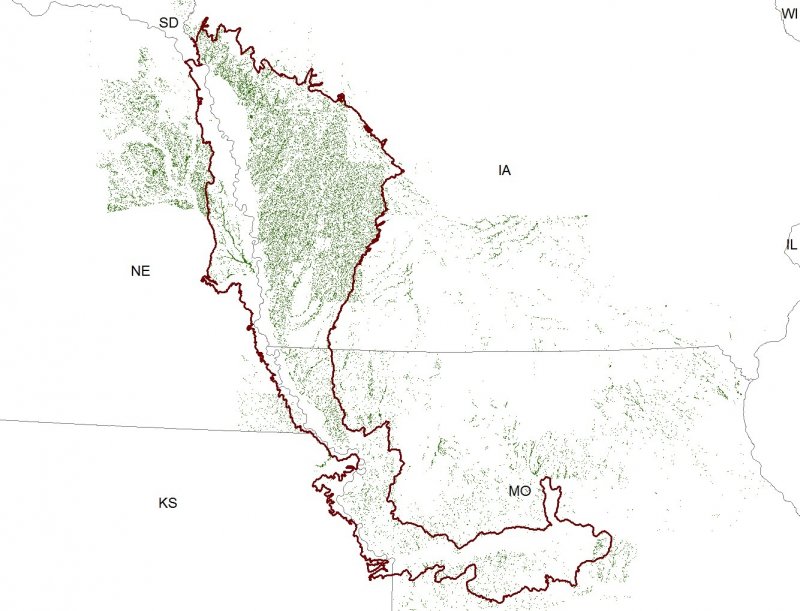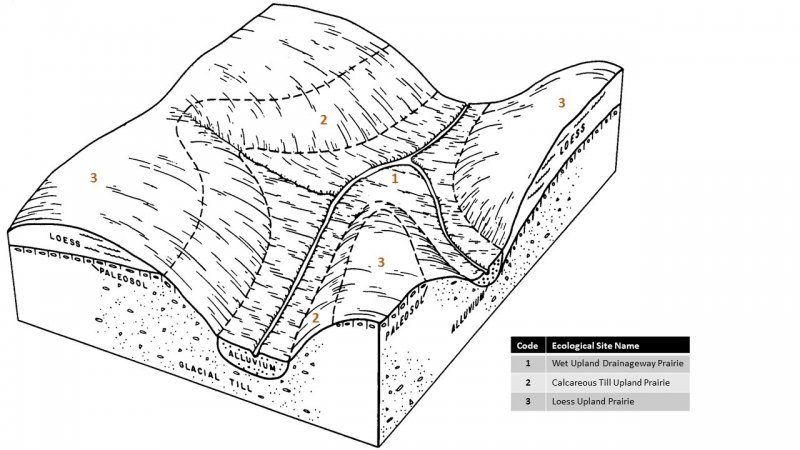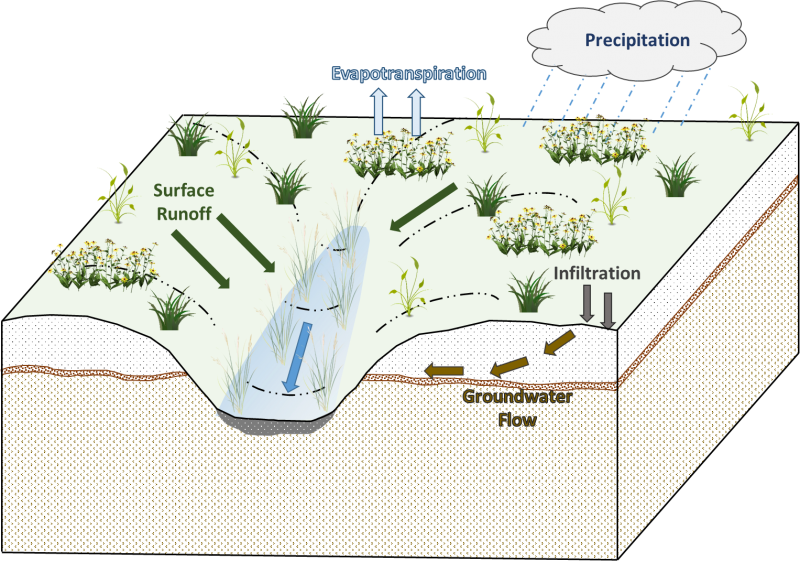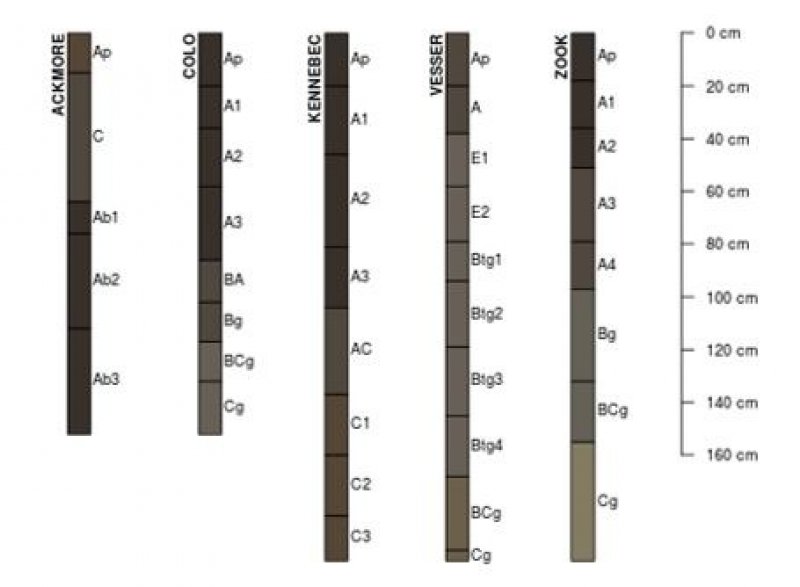
Natural Resources
Conservation Service
Ecological site R107XB024IA
Wet Upland Drainageway Prairie
Last updated: 5/21/2020
Accessed: 12/21/2025
General information
Provisional. A provisional ecological site description has undergone quality control and quality assurance review. It contains a working state and transition model and enough information to identify the ecological site.
Figure 1. Mapped extent
Areas shown in blue indicate the maximum mapped extent of this ecological site. Other ecological sites likely occur within the highlighted areas. It is also possible for this ecological site to occur outside of highlighted areas if detailed soil survey has not been completed or recently updated.
MLRA notes
Major Land Resource Area (MLRA): 107X–Iowa and Missouri Deep Loess Hills
The Iowa and Missouri Deep Loess Hills (MLRA 107B) includes the Missouri Alluvial Plain, Loess Hills, Southern Iowa Drift Plain, and Central Dissected Till Plains landform regions (Prior 1991; Nigh and Schroeder 2002). It spans four states (Iowa, 53 percent; Missouri, 32 percent; Nebraska, 12 percent; and Kansas 3 percent), encompassing over 14,000 square miles (Figure 1). The elevation ranges from approximately 1565 feet above sea level (ASL) on the highest ridges to about 600 feet ASL along the Missouri River near Glasgow in central Missouri. Local relief varies from 10 to 20 feet in the major river floodplains, to 50 to 100 feet in the dissected uplands, and loess bluffs of 200 to 300 feet along the Missouri River. Loess deposits cover most of the area, with deposits reaching a thickness of 65 to 200 feet in the Loess Hills and grading to about 20 feet in the eastern extent of the region. Pre-Illinoian till, deposited more than 500,000 years ago, lies beneath the loess and has experienced extensive erosion and dissection. Pennsylvanian and Cretaceous bedrock, comprised of shale, mudstones, and sandstones, lie beneath the glacial material (USDA-NRCS 2006).
The vegetation in the MLRA has undergone drastic changes over time. Spruce forests dominated the landscape 30,000 to 21,500 years ago. As the last glacial maximum peaked 21,500 to 16,000 years ago, they were replaced with open tundras and parklands. The end of the Pleistocene Epoch saw a warming climate that initially prompted the return of spruce forests, but as the warming continued, spruce trees were replaced by deciduous trees (Baker et al. 1990). Not until approximately 9,000 years ago did the vegetation transition to prairies as climatic conditions continued to warm and subsequently dry. Between 4,000 and 3,000 years ago, oak savannas began intermingling within the prairie landscape. This prairie-oak savanna ecosystem formed the dominant landscapes until the arrival of European settlers (Baker et al. 1992).
Classification relationships
Major Land Resource Area (MLRA): Iowa and Missouri Deep Loess Hills (107B) (USDA-NRCS 2006)
USFS Subregions: Central Dissected Till Plains Section (251C), Deep Loess Hills (251Ca) Subsection; Nebraska Rolling Hills Section (251H), Yankton Hills and Valleys (251Ha) (Cleland et al. 2007)
U.S. EPA Level IV Ecoregion: Steeply Rolling Loess Prairies (47e), Rolling Loess Prairies (47f), Nebraska/Kansas Loess Hills (47h), Western Loess Hills (47m) (USEPA 2013)
Biophysical Setting (LANDFIRE 2009): Central Tallgrass Prairie (4214210)
Ecological Systems (National Vegetation Classification System, Nature Serve 2015): Central Tallgrass Prairie (CES205.683)
Iowa Department of Natural Resources (INAI nd): Eastern Wet-Mesic Prairie
Lauver et al. (1999): Glaciated Tallgrass Prairie
Missouri Natural Heritage Program (Nelson 2010): Wet-Mesic Bottomland Prairie
Nebraska Game and Parks Commission (Steinauer and Rolfsmeier 2010): Lowland Tall-Grass Prairie
Plant Associations (National Vegetation Classification System, Nature Serve 2015): Andropogon gerardii – Panicum virgatum – Helianthus grosseserratus Wet Meadow (CEGL002024)
Ecological site concept
Wet Upland Drainageway Prairies are generally located within the green areas on the map (Figure 1). They occur on drainageways with slopes typically less than five percent in uplands. Soils are Entisols and Mollisols that are poorly to well-drained and very deep, formed from loess. The site experiences occasional to frequent, brief flooding from precipitation, overland flow, and groundwater return flow. As a result, the native plant community is comprised of wet-mesic herbaceous tallgrass vegetation.
The historic pre-European settlement vegetation on this site was dominated by tallgrass prairie species adapted to temporarily-flooded habitats. Prairie cordgrass (Spartina pectinata Bosc ex Link) and switchgrass (Panicum virgatum L.) are the dominant monocot species for this ecological site (Nelson 2010; Steinauer and Rolfsmeier 2010). Other common and characteristic grasses and grass-likes include eastern gamagrass (Tripsacum dactyloides (L.) L.), big bluestem (Andropogon gerardii Vitman), Virginia wildrye (Elymus virginicus L.), awlfruit sedge (Carex stipata Muhl. ex Willd.), and troublesome sedge (Carex molesta Mack. ex Bright). Forb species typical of an undisturbed plant community associated with this ecological site include Virginina bunchflower (Veratrum virginicum (L.) W.T. Aiton), groovestem Indian plantain (Arnoglossum plantagineum Raf.), and downy phlox (Phlox pilosa L.) (Drobney et al. 2001; Nelson 2010; Ladd and Thomas 2015). Willows (Salix L.), black cherry (Prunus serotina Ehrh.), chokecherry (Prunus virginiana L.), and roughleaf dogwood (Cornus drummondii C.A. Mey.) are common shrubs that can be found lightly scattered throughout the prairie (Nelson 2010; Steinauer and Rolfsmeier 2010). Fire was the primary disturbance factor that maintained this site, while drought and native large mammal grazing were secondary factors (LANDFIRE 2009; Nelson 2010; NatureServe 2015).
Associated sites
| R107XB007MO |
Loess Upland Prairie Loess soils on upland summits, shoulders, and backslopes, including Arisburg, Arispe, Arthur, Exira, Marshall, Minden, and Polo |
|---|
Similar sites
| R107XB022IA |
Wet Upland Depression Prairie Wet Upland Depression Prairies are similar in landscape position but site is a DEPRESSIONAL wetland on slopes less than two percent that allows water to pond |
|---|
Table 1. Dominant plant species
| Tree |
Not specified |
|---|---|
| Shrub |
Not specified |
| Herbaceous |
(1) Spartina pectinata |
Click on box and path labels to scroll to the respective text.




